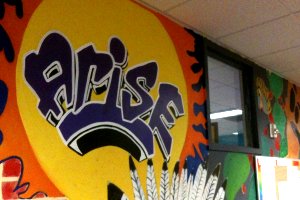[jwplayer config="QUEST Audio Player" skin="http://ww2.kqed.org/quest/wp-content/themes/quest/glow.zip" file="http://www.kqed.org/.stream/anon/radio/quest/2011/02/2011-02-21-quest.mp3"]
Listen to the QUEST radio story about The Heroic Imagination Project.
In 1971, when he was a young psychology professor at Stanford University, Zimbardo came up with an idea for an unusual psychology experiment.
Twenty-four students were drafted to spend two weeks living in a fake prison in a basement on the Stanford campus. Half were randomly assigned to be guards, the other half prisoners.
By the fifth day, things had gotten out of hand. The guards had started to develop sadistic behavior, humiliating and abusing the prisoners. The prisoners had become passive; some had emotional breakdowns. And yet no one asked to be removed from the experiment. The power of the situation, says Zimbardo, had taken over.
“We’ve all been taught that there’s a physical, permeable line between good and evil,” he said recently in an interview. “We are on the good side, and they, the evil doers, are on the other side. What our study showed was that anybody could be seduced across that line.”
The Stanford Prison Experiment has been used to explain everything from Nazi Germany and the Rwandan Genocide, to Abu Graib -- places where seemingly normal people crossed the line between good and evil.
Zimbardo is 77 now. And while he doesn’t say so directly, it seems fair to imagine that he’s looking for a more optimistic legacy. If normal people can be turned into sadists, then couldn’t the opposite be true? Couldn’t normal people be seduced into heroism?
Which brings us up to the present day, to a charter high school in Oakland, called ARISE. It’s a small, hopeful kind of place, where many of the students will be the first in their families to go to college.
For the last year, a handful of students here have been taking part in a new program, being developed by Zimbardo and others. It’s called the Heroic Imagination Project. The student participants call themselves the Jedi Knights.
This curriculum is far from a science, but the idea is that over the course of the year, students will watch psychology videos, study history, and try to identify everyday heroes in their own lives. The potential danger of conformity is a big theme. If students can understand how powerful herd mentality can be, maybe they can also learn to pierce through it.
“You want to try and follow the crowd,” said ARISE junior Gavino Segura, during a recent Heroic Imagination Project class, “but, it’s like we’re learning to take steps not to do that, so that we can take our own steps, instead of being like every other person.
“We want to democratize the idea of hero,” says Zimbardo. “You don’t have to have any special talents to be a hero. You just have to be able to act, when most people don’t.”
In the years since The Prison Experiment, technology has brought vast changes to the field of psychology. Experiments like what Zimbardo did in 1971 are now considered unethical. What’s replaced them, in part, are experiments that look at the brain itself.
“We have all these neuro-imaging tools that allow us to get under the skull, so to speak,” says Philipe Goldin, a clinical psychologist and neuroscientist at Stanford. “We can see the brain in action.”
In many ways, Goldin’s work echoes what Zimbardo is trying to do now, with high school kids.
For example, Goldin’s particularly interested in an area deep in the brain called the salience network, which is responsible for attaching value to specific people, places or objects. The salience network, for example, is part of what determines whether people decide to reach out and help someone, or to just keep walking.
Goldin says it’s possible, through the use of guided meditation, to actually expand a person’s salience network – essentially, to make them care about a broader group of people, including strangers. He says these changes actually show up in brain scans.
“If we can begin to recognize others suffering more acutely, more fully,” says Goldin, “we can actually become more open to the possibility of acting in the moment, when those moments arise.”
In other words, acting heroically.
During one of my visits to the high school, one of those moments took place. A fight – not students, but kids from outside -- spilled into the hallways.
For the heroism students, it was like reality had just crashed the class. Maybe, they wondered, this was exactly one of those opportunities they’d been talking about, a chance to step up.
But no one did, said senior Philip Johnson.
“Students could have been, like, you know, someone come get this person. It shouldn’t have been a group of people watching. You know?”
This is a hard neighborhood to be a hero in, the students say. Gang activity is right out the front door. Getting involved can get you killed. The Jedi knights say they have a lot to learn.
 If there is one thing Stanford Professor Phillip Zimbardo is known for, it's that normal people can be turned into sadists. Can he leave a more optimistic legacy and prove the opposite to be true?
If there is one thing Stanford Professor Phillip Zimbardo is known for, it's that normal people can be turned into sadists. Can he leave a more optimistic legacy and prove the opposite to be true?